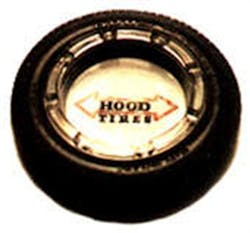Like pinstripe suits, manual typewriters and three-martini lunches, tire ashtrays are relics from a corporate world long gone. And since smoking's removal from the American lexicon of cool during the puritanical 1980s, many of these now-politically incorrect items have been relegated to attics, basements, desk drawers and garages.
Others (like the Hood Rubber Co. tray from the early 1930s pictured) have fallen into the hands of collectors like Mylo Imsdahl.
Imsdahl, owner of The Tire Shop -- a small, single-location retail dealership in Santa Rosa, Calif. -- collects tire ashtrays with the same zeal others apply to rare coins or baseball cards. His 300-piece collection represents more than a dozen current and defunct tire manufacturers from around the world and took more than 15 years to build. Fellow ashtray collectors hail it as one of the most comprehensive displays of its type in existence. In fact, fans from as far away as Ohio and Georgia have even traveled to the West Coast to see Imsdahl's collection!
Tire and rubber manufacturers started building ashtrays in the early 1900s as promotional give-a-ways (the oldest piece Imsdahl owns dates back to 1910). Early models were made of glass and metal; rubber became a part of their design in the early 1920s.
More than 50 companies made tire ashtrays at the height of their production in the 1930s, according to Imsdahl. But manufacturing was severely curtailed during the war effort a few years later when "thousands of ashtrays were lost to the rubber drive."
Most tiremakers that resumed production after the war, like Cooper Tire & Rubber Co. and General Tire & Rubber Co., eventually phased out ashtrays during the 1960s and '70s. "Firestone and BFGoodrich continued on, but by the '90s they were all gone, except for Goodyear and Kelly-Springfield." Goodyear still offers six different tire ashtray models.
Tire ashtray collectors range "from one end of the spectrum to the other, but most are middle-age, middle-class people," Imsdahl says. "Quite a few collectors have links to the tire industry, but they all seem to be into automobiles of some sort."
The "holy grails" of tire ashtrays, according to the collector, are two models produced in the early 1900s by now-defunct Overman Tire, a New Jersey-based manufacturer whose company mascot was a devil. The first ashtray features a male devil. There are only three or four known to exist.
The second tray depicts a nude female devil (imagine trying to get the corporate green light to make that design today!). Only two are known to exist today.
Each tray would probably sell for at least $2,000, Imsdahl says, though he notes their current owners have no plans to part with them. However, other collectors are eager to put their ashtrays on the market -- "usually to streamline their collections" -- and a lot are using Internet auction service eBay as a virtual clearinghouse. At press time, there were 110 tire ashtrays up for grabs on the site; asking prices ranged from $3 to $75.
"Right now, eBay is the easiest place to find tire ashtrays," Imsdahl says. Other good sources include antique shops, flea markets, estate fairs and automotive swap meets.
Far from being one-dimensional products, tire ashtrays also are finding new lives as paperweights, paper clip holders, spare change receptacles and even clocks.
As far as he knows, there is no national tire ashtray collectors' club. However, Imsdahl has been approached about organizing one. "If I only had the time," he muses. So many people throughout the United States collect the items that "it would be a huge undertaking."



